JumpQuest-Integrated Design Philosophy
CAI CHUN MAN
7/19/20255 min read
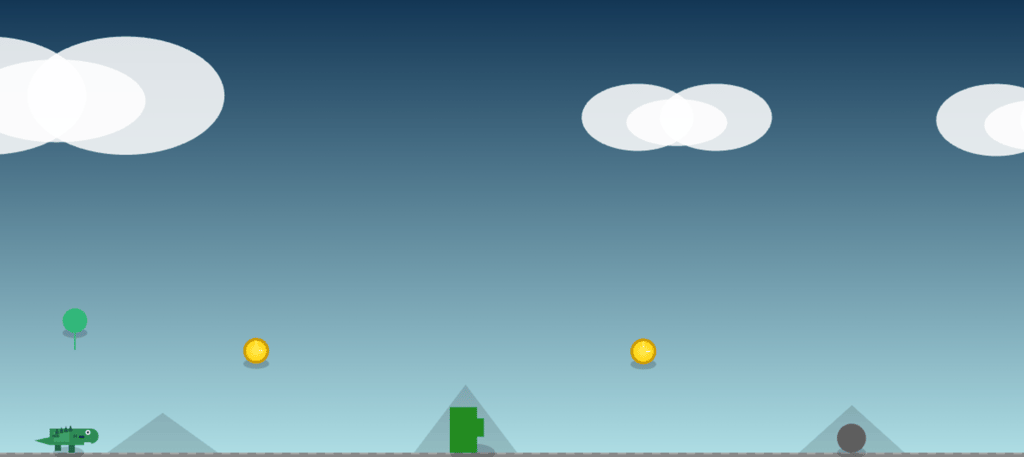

JumpQuest is CM Arcade’s inaugural action runner: a web-based dinosaur game that embraces the purity of a single primary action while refusing to accept shallow engagement as an inevitability. Our central question is modern and blunt: How can an intentionally simple, one-button experience sustain attention inside an over-stimulated, low-focus, reward-loop culture? Our answer is to layer clarity, micro-progression, strategic resource tension, and identity expression—carefully—so that depth emerges without cognitive overload. Every system working behind the scenes—state transitions, audio feedback, evolving speed curve, achievements grid, timed power skin, persistent storage—is chosen for one unifying purpose: lower the barrier to start, multiply the reasons to continue.
At the foundation sits a disciplined state model that cleanly separates normal play, shops, tutorial/info display, achievement viewing, revival choice, and end-of-run reflection*(A2). This segmentation protects the player from accidental inputs (like unintended jumps during a purchase) and provides clean seams for future expansion (such as experimental modes) without destabilizing the core loop. The mechanical heartbeat remains minimal—jump to avoid obstacles—yet the experience around that verb becomes progressively more textured through pacing and layered incentives.
Difficulty is not left to chaotic randomness; instead an intentional, multi-segment acceleration curve governs both game speed and obstacle spawn density. The earliest seconds form a gentle onboarding basin; mid-game phases incrementally compress reaction windows; a late surge transforms routine into self-imposed mastery trials. Because this escalation is structured, players can internalize rhythm, plan power timings, and experience a tangible arc each run rather than an indistinct blur of random hardship.
Around the central act of jumping we construct a resource economy that makes even small coin totals feel meaningful. A modest fee to enter the utility shop introduces an explicit cost to deliberation itself: you choose to strategize rather than being handed upgrades for free. Within that shop, each purchasable element—shield (error insurance), shoes (ten-second double-jump window), potential revive later (run continuation), and cosmetic skins (identity, not power)—embodies a different risk lens* (A2). The player must weigh immediate survivability against future contingency. This light, recurring triage carves micro-moments of strategic thought into what could otherwise dissolve into pure reflex.
Clarity of temporary power is fundamental. The double jump period, formerly ambiguous in earlier iterations, is now unmissably telegraphed through a distinct temporary skin whose visual shrink mirrors a real, short-lived advantage: increased mobility plus a smaller exposure profile. This dual cue—altered look and perceptible size change—answers two player questions instantly: “Is the ability active?” and “How long will it last?” Just as importantly, we draw a bright ethical line: cosmetic skins acquired for style alone do not alter physical effectiveness. Fairness is explicit—only earned, time-bounded ability states shift size, never paid cosmetics. That principle sustains trust and inoculates the design against “pay-to-win” perceptions.
The achievement lattice translates invisible learning into visible progress. Structured tiers (coin milestones, score thresholds, revive counts, chest openings) gently shepherd new players toward underexplored mechanics (e.g., reviving or timing power usage) while giving advanced players stretch objectives that frame improvement. Instant on-screen toasts and bright micro-audio confirmations create rhythmic pulses of recognition without halting flow. This system is intentionally data-driven and declarative so that future achievements can be dropped in rapidly, preserving iterative agility.
Moment-to-moment ambiance matters. A subtle day–night color gradient cycles in the background, clouds and distant silhouettes glide with parallax-like differentials, and everything remains visually lean to keep mobile performance crisp*(A1). These touches serve mood and a sense of elapsed time, not distraction. Similarly, the sonic identity—lightweight synthesized beeps for core events—delivers immediate tactile feedback with virtually zero bandwidth cost, reinforcing action-result loops crucial to reinforcing habit formation.
Persistence via local storage gives each session context: best score, best time, unlocked achievements, and last chosen skin endure beyond the browser tab’s life. This quiet remembering transforms isolated runs into a personal narrative—“my progression,” “my tailored dino”—which in turn raises the psychological cost of abandonment and makes re-engagement frictionless*(A2).
Looking ahead, Mono Mode is the next controlled experiment. By stripping the palette to blacks, whites, and greys, we will test whether reduced chromatic stimulation heightens focus, extends session length, and improves silhouette readability. The challenge shifts from color differentiation to luminance mapping and texture/pattern signaling. Proposed solutions include hierarchical greys, bold outline contrast, and non-color telegraphing (e.g., pulsing borders) for active powers. Crucially, we will integrate this as a mode toggle rather than a fork, maintaining a single evolving code and design base.
Our ethical posture is straightforward: no permanent statistical advantage will hide behind payment walls. Monetization, if introduced later, stays cosmetic or experiential (themes, auditory packs) and never undermines the skill economy. Run restarts remain instantaneous; there is no enforced downtime, energy gating, or manipulation of frustration windows. The design respects the player’s time, framing failure as a fast re-entry learning signal rather than a monetized waiting period.
From an engineering and process perspective, we remain deliberately light but structurally ready. Constants (speed thresholds, spawn cadences, reward yields) are positioned for data-table extraction; achievements are predicate-defined anticipating expansion; a clear state core invites modular insertion of analytics (for balancing), post-run summaries (to convert emotion into reflection), or social hooks without rewriting fundamentals. The next incremental improvements—run summary panel, Mono Mode palette toggling, additional achievement categories, fairness note in the Tutorial/Info page—fit seamlessly inside the existing design contract.
Recruitment and community growth are woven transparently into the experience: an understated invitation in the Info/Tutorial overlay—Interested in design, coding, market analysis, or web performance? Contribute: arcade@caichunman.com—aligns with CM Arcade’s educational ethos that this is both a game and a live laboratory for honing real-world problem-solving and product iteration skills.
In synthesis, JumpQuest enforces a stringent rubric for every feature: it must clarify state, enhance agency, provide immediate and legible feedback, or deepen identity and long-term motivation. The core verb remains single and approachable; the emergent experience is layered and renewable. Reflex tension produces coins; coins foster strategic trade-offs; trade-offs fuel achievement pursuit; achievements unlock identity; identity reinforces replay; replay feeds mastery against a crafted escalation curve. Planned innovations—Mono Mode, enhanced achievements, reflective summaries—are refinements orbiting the same central loop of clarity → choice → feedback → identity. This is CM Arcade’s design DNA: iterate deliberately, keep the surface elegant, let depth emerge through systemic interplay, and invite motivated collaborators to build the next layer with us at arcade@caichunman.com. For players, the promise is straightforward: JumpQuest will respect your time, reward your learning, and evolve with you—beginning with a single jump.
(Reference image for the double jump active skin remains here, both for internal clarity and public transparency: https://assets.zyrosite.com/YNqro9XqMPslEE9j/b6643d40-a026-4b41-ba51-ceb5f9d8c545-Yg2yvqqa1WHM144B.png)



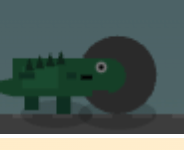
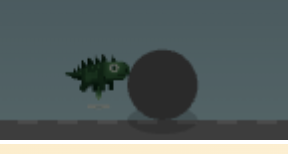

Default Skin
Double-Jump Skin
Paid Cosmetic skin
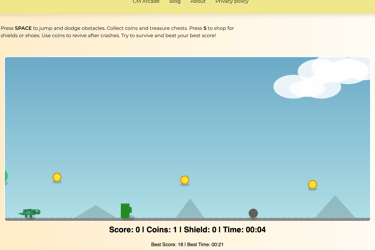

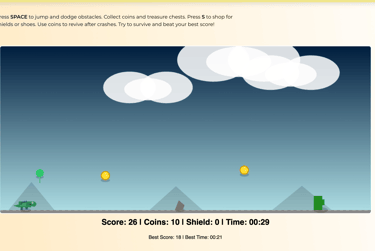

A1*
A2*


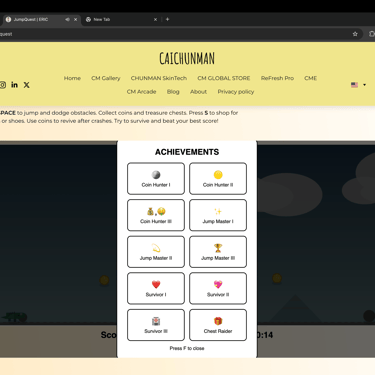
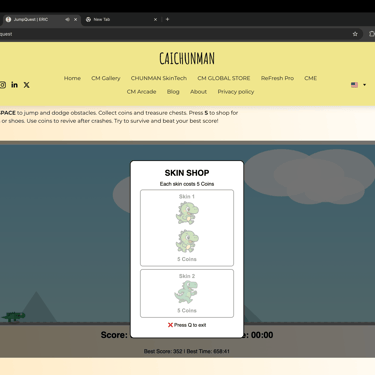
CAICHUNMAN
Phone and email
Contact
+852 63681518
© 2025. All rights reserved.
+1(415)374-0790
hku@caichunman.com
CAICHUNMAN@caichunman.com
